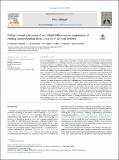Distinct neural substrates of individual differences in components of reading comprehension in adults with or without dyslexia
Author(s)
Ozernov-Palchik, Ola; Centanni, TM; Beach, Sara Dawley; May, Steven J.; Hogan, T; Gabrieli, John; ... Show more Show less
DownloadPublished version (1.750Mb)
Publisher with Creative Commons License
Publisher with Creative Commons License
Creative Commons Attribution
Terms of use
Metadata
Show full item recordAbstract
Reading comprehension is a complex task that depends on multiple cognitive and linguistic processes. According to the updated Simple View of Reading framework, in adults, individual variation in reading comprehension can be largely explained by combined variance in three component abilities: (1) decoding accuracy, (2) fluency, and (3) language comprehension. Here we asked whether the neural correlates of the three components are different in adults with dyslexia as compared to typically-reading adults and whether the relative contribution of these correlates to reading comprehension is similar in the two groups. We employed a novel naturalistic fMRI reading task to identify the neural correlates of individual differences in the three components using whole-brain and literature-driven regions-of-interest approaches. Across all participants, as predicted by the Simple View framework, we found distinct patterns of associations with linguistic and domain-general regions for the three components, and that the left-hemispheric neural correlates of language comprehension in the angular and posterior temporal gyri made the largest contributions to explaining out-of-scanner reading comprehension performance. These patterns differed between the two groups. In typical adult readers, better fluency was associated with greater activation of left occipitotemporal regions, better comprehension with lesser activation in prefrontal and posterior parietal regions, and there were no significant associations with decoding. In adults with dyslexia, better fluency was associated with greater activation of bilateral inferior parietal regions, better comprehension was associated with greater activation in some prefrontal clusters and lower in others, and better decoding skills were associated with lesser activation of bilateral prefrontal and posterior parietal regions. Extending the behavioral findings of skill-level differences in the relative contribution of the three components to reading comprehension, the relative contributions of the neural correlates to reading comprehension differed based on dyslexia status. These findings reveal some of the neural correlates of individual differences in the three components and the underlying mechanisms of reading comprehension deficits in adults with dyslexia.
Date issued
2021-02Department
McGovern Institute for Brain Research at MITJournal
NeuroImage
Publisher
Elsevier BV
Citation
Ozernov-Palchik, O. et al. "Distinct neural substrates of individual differences in components of reading comprehension in adults with or without dyslexia." NeuroImage 226 (February 2021): 117570. © 2020 The Authors
Version: Final published version
ISSN
1053-8119